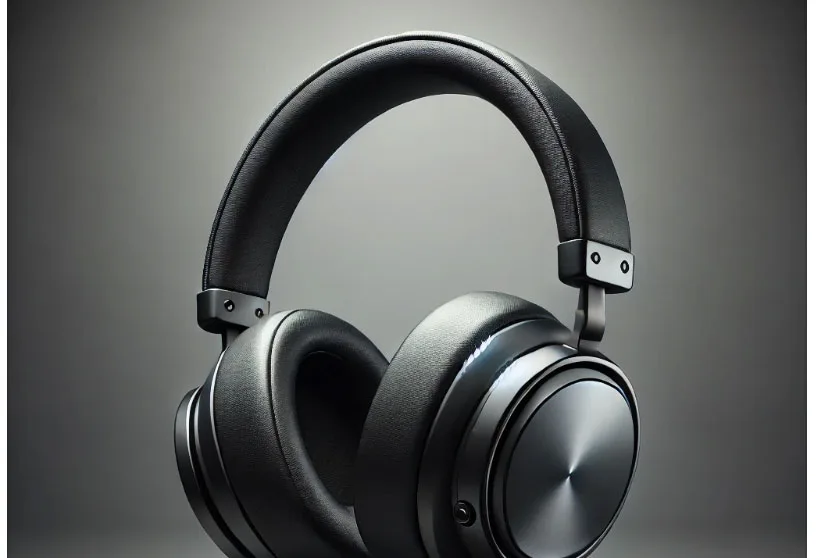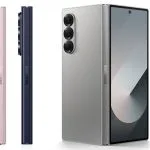Let’s take a look at the different types of headphones that are available for electronic devices. Headphones are high-tech accessories that cater to a wide range of uses, preferences, and environments. Today, choosing the right type of headphones depends on several factors, such as sound quality, comfort, and intended use.
1. Over-Ear Headphones (Circumaural)
Over-ear headphones, also known as circumaural headphones, are designed to completely cover the ears. These headphones have large ear cups that fully enclose the listener’s ears, creating a seal that blocks out ambient noise while enhancing sound quality.
Benefits:
- Sound Isolation: Over-ear headphones are great for providing passive noise isolation due to the design that covers the ears. Some models come with active noise cancellation (ANC) features, making them ideal for travel and noisy environments.
- Comfort: The large ear cups and padded headbands are designed for long listening sessions, making them more comfortable for extended use compared to smaller models.
- Sound Quality: Over-ear headphones typically offer superior sound quality, with deeper bass, clear mids, and crisp highs, making them the choice for audiophiles.
Drawbacks:
- Portability: Due to their large size, they are less portable than other headphone types.
- Weight: They tend to be heavier, which can cause discomfort during long-term use.
Best Uses:
- Listening to music at home or in a quiet environment.
- Professional audio editing and production.
2. On-Ear Headphones (Supra-Aural)
On-ear headphones rest on top of the ears rather than covering them completely. They are smaller and lighter than over-ear headphones, making them more portable.
Benefits:
- Portability: On-ear headphones are more compact than over-ear models, making them easier to carry around.
- Breathability: They don’t completely enclose the ear, allowing for more airflow, which reduces heat buildup during extended use.
Drawbacks:
- Comfort: Since they rest on the ears, they can cause discomfort after prolonged use.
- Sound Leakage: On-ear headphones often allow more ambient sound in and can leak sound out, making them less ideal for public spaces.
Best Uses:
- Commuting and travelling.
- Casual listening at home or in the office.
3. In-Ear Headphones (Earbuds)
In-ear headphones, also called earbuds, fit directly into the ear canal. These headphones are the most portable type, often coming bundled with smartphones and other portable devices.
Benefits:
- Portability: In-ear headphones are highly portable due to their small size, making them easy to carry around in a pocket or bag.
- Noise Isolation: Many in-ear headphones offer excellent passive noise isolation because they form a seal within the ear canal, effectively blocking outside noise.
- Affordability: They come in a wide price range, with affordable options available for every budget.
Drawbacks:
- Comfort: Some people find in-ear headphones uncomfortable, especially when used for long periods.
- Sound Quality: While premium models can offer good sound quality, cheaper versions often sacrifice audio performance for affordability.
Best Uses:
- Exercising and sports activities.
- Commuting and traveling.
- Listening on the go.
4. Open-Back Headphones
Open-back headphones feature an open design that allows air and sound to pass through the ear cups. This design provides a more natural and spacious sound experience, as the audio can interact with the environment.
Benefits:
- Sound Quality: Open-back headphones are praised for their natural sound reproduction, making them a favorite for audiophiles and sound engineers. They deliver a more immersive soundstage, giving the listener the impression that the sound is coming from the environment rather than inside their head.
- Comfort: The open design also prevents heat buildup, making these headphones more comfortable for extended use.
Drawbacks:
- Sound Leakage: Because they allow sound to escape, open-back headphones are not ideal for use in public or shared spaces.
- Noise Isolation: They offer very little noise isolation, so they are best used in quiet environments.
Best Uses:
- Critical listening in a quiet environment.
- Home audio systems.

5. Closed-Back Headphones
In contrast to open-back headphones, closed-back headphones have a sealed design that prevents sound from escaping. This design enhances noise isolation, making them a popular choice for use in noisy environments.
Benefits:
- Noise Isolation: Closed-back headphones offer superior noise isolation, keeping the sound inside and blocking outside noise. This makes them ideal for use in noisy places like public transport or busy offices.
- Enhanced Bass: The closed design tends to accentuate lower frequencies, making closed-back headphones a good choice for bass-heavy music genres.
Drawbacks:
- Soundstage: While closed-back headphones can offer great sound quality, they typically don’t provide the spacious, natural soundstage that open-back headphones deliver.
- Heat Buildup: The enclosed ear cups can cause heat and moisture buildup during long listening sessions.
Best Uses:
- Recording studios and sound production.
- Commuting and travel.
- Gaming.
6. Noise-Canceling Headphones
Noise-canceling headphones come with built-in technology that actively reduces unwanted ambient sounds. These headphones use microphones to pick up external noise and generate sound waves that cancel it out, providing an isolated listening experience.
Benefits:
- Active Noise Cancellation (ANC): These headphones are excellent for eliminating background noise, making them perfect for flights, commuting, and noisy work environments.
- Enhanced Focus: With distractions reduced, users can focus more on their music, podcast, or work.
Drawbacks:
- Cost: Noise-canceling headphones are generally more expensive due to the technology involved.
- Battery Life: The ANC feature drains battery power, so they need to be charged regularly if they are wireless.
Best Uses:
- Airplane travel and long commutes.
- Work environments where concentration is needed.
7. Wireless Headphones
Wireless headphones eliminate the need for cables, connecting to devices via Bluetooth or other wireless technologies. They are available in various forms, including over-ear, on-ear, and in-ear designs.
Benefits:
- Convenience: Without wires, wireless headphones provide more freedom of movement, making them ideal for workouts, commuting, and general everyday use.
- Portability: Wireless in-ear headphones (like AirPods) are extremely portable, fitting easily into small pockets or bags.
Drawbacks:
- Battery Dependency: Wireless headphones require regular charging, and if the battery dies, they cannot be used until recharged.
- Sound Quality: While wireless technology has improved over the years, wired headphones still tend to offer better sound quality, particularly for audiophiles.
Best Uses:
- Exercising and sports.
- Commuting and travel.
- Casual listening.
8. Bone Conduction Headphones
Bone conduction headphones use vibrations to transmit sound directly through the bones of the skull to the inner ear, bypassing the eardrum. This type of headphone is particularly useful for individuals with hearing impairments or those who want to stay aware of their surroundings.
Benefits:
- Situational Awareness: Since the ear canal is not obstructed, users can still hear their environment, making them ideal for outdoor activities like running or cycling.
- Comfort: Bone conduction headphones are lightweight and rest outside the ear, making them comfortable for extended use.
Drawbacks:
- Sound Quality: The audio quality is generally inferior to traditional headphones, particularly in terms of bass response.
- Cost: Bone conduction headphones can be relatively expensive compared to other types with better sound quality.
Best Uses:
- Outdoor activities such as running or cycling.
- Situations where situational awareness is essential.
Conclusion
Headphones come in a wide range of types, each designed to cater to specific needs and preferences. Whether you’re an audiophile seeking the highest sound quality, a commuter needing noise cancellation, or an athlete looking for wireless freedom, there’s a type of headphone suited for you. Understanding the key features, benefits, and limitations of each type can help you make an informed decision and find the best headphones for your lifestyle.
Arthur is a senior member of the communications team who has worked at several well-known companies over the past 10 years. As a writer with many years of experience in the technology sector, focusing on reviewing mobile phones and accessories, he has written about many products or has been hands-on with them at some point



